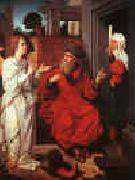 |
Jan Provost -- Click Here
|
|
1465-1529 Flemish Jan Provost Gallery
Jan Provoost, or Jan Provost (1462/5, Mons?CJanuary 1529, Bruges) was a Flemish painter. He was one of the most famous Netherlandish painters of his generation, a prolific master who left his early workshop in Valenciennes to run two workshops, one in Bruges, where he was made a burgher in 1494, the other simultaneously in Antwerp, which was the economic center of the Low Countries. Provoost was also a cartographer engineer and architect. He met Albrecht D??rer in Antwerp in 1520, and a D??rer portrait drawing at the National Gallery, London, is conjectured to be of Provoost. He married the widow of the miniaturist and painter Simon Marmion, after whose death he inherited the considerable Marmion estate.
The styles of Gerard David and Hans Memling can be detected in Provoost's religious paintings. The Last Judgement painted for the Bruges town hall in 1525 is the only painting for which documentary evidence identifies Provoost. Surprising discoveries can still be made: in 1971 an unknown and anonymous panoramic Crucifixion from the village church at Koolkerke was identified as Provoost's. It is on permanent loan to the Groeninge Museum, Bruges. |
|
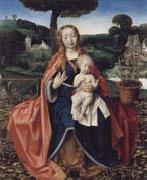 |
Jan provoost -- Click Here
|
|
Dutch, born circa 1465-1529,South Netherlandish painter. He probably came into contact with Simon Marmion, the renowned painter and book illuminator from Valenciennes, via Jacquemart Pilavaine, a publisher and illuminator in his native Bergen. Provoost married Marmion's widow, Jeanne de Quaroube, before 1491, and it is thus assumed that Marmion was his teacher. In 1493 Provoost moved to Antwerp, a promising town for artists, where he registered as a master in the Guild of St Luke, but in 1494 he travelled to Bruges. He became a citizen there and soon played an important part in the painters' guild. In 1506 Maximiliaen Frans (1490-1547) was his pupil. Provoost received commissions for decorative work from the town council and church authorities in 1509, 1513 and 1520, the year of the Triumphal Entry of Charles V into Bruges, for which he worked on the decorations. He returned to Antwerp the same year to meet Albrecht Derer, who may have drawn his portrait. Derer visited Bruges in April 1521 and was Provoost's guest. Of Jan Provoost's children, Adriaen Provoost (b 1508) became a painter and Thomas Provoost a glassmaker, both active in Bruges. Jan Provoost's time as a pupil in a northern French miniaturist's workshop was of decisive influence on his later oeuvre. His work radiates assurance, with its precise drawing, restrained expression and airy landscapes, and he was successful in Bruges, where there was little competition after Hans Memling's death in 1494. |
|
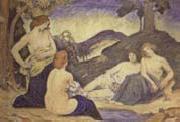 |
Jan Preisler -- Click Here
|
|
Czechoslovakian, 1872-1918
Bohemian painter. He studied at the School of Applied Arts in Prague (1887-95). In 1906 he visited Belgium, the Netherlands and Paris. He taught at the Academy of Arts in Prague from 1913. He was a pioneer in modern Bohemian art, and his work developed from pure Art Nouveau and Symbolism towards Expressionism, in three phases. The period 1887-1900 is represented by the triptych Spring (1900; Prague, Trade Fair Pal.): with its lack of scales of tonal value or Impressionist instantaneousness, it is a skilful use of colour and composition. The figure of the boy with autobiographical features is symbolic of a whole generation. The period 1901-7 culminated in Painting from a Bigger Cycle (1901-2; Prague, Trade Fair Pal.), which balances vertical and horizontal lines and employs bright colour combinations. In Black Lake (1904; Prague, Trade Fair Pal.), which deals with the misery and excitement of first love, the contrast of black and white and the figure of the boy with a horse and a girl evoke the transitive moment between reality and dream. Spring (1906; Prague, Trade Fair Pal.), a testament to Preisler admiration for the work of Gauguin, develops the resonant contrast of green, yellow and white. In 1908-18 Preisler returned to monumental decoration: of the Palacky Room in the Municipal House in Prague, 1910-12, in the style of Puvis de Chavannes. At this time he was approaching the Expressionism of the younger generation from the Eight (ii), especially in the three versions of the painting Good Samaritan (1910-13; all priv. col., see Kotalok, pl. 41), which shows the influence of Daumier and Munch. |
|
|
|
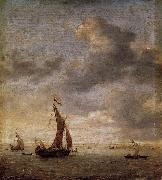 |
Jan Porcellis -- Click Here
|
|
(1583/5 - 29 January 1632) was a Dutch marine artist.
Porcellis was born in Ghent. He was the father of the marine artist Julius Porcellis (they shared a similar repertoire of subjects and an identical signature monogram), and is generally agreed to be the more fluent artist, particularly in his sense of space and his tonal palette (subtler than his son's). He died at Zoeterwoude.
|
|
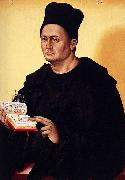 |
Jan Polack -- Click Here
|
|
Jan Polack Johannes Po(l)lack (Hanns Polagk, Polegk), (Latin: Ioannes Polonus) (between 1435 and 1450 (possibly in Krakew) - 1519 in Munich) was a 15th-century painter.
From his nickname it is assumed that he might have worked in Krakew. From the mid-1470s on, he lived and worked in Munich, having previously been in Franconia. He may have taken part in the 1475 festival of the Landshut Wedding of Jadwiga Jagiellon and George of Bavaria. In 1480 he opened his own shop in Munich.
Starting in 1482 he is listed on the tax records of Munich, also as leader of the local painter guild. He visited with Michael Wohlgemuth and his art was influenced by him and by that of Veit Stoss and Hans Pleydenwurff as well as by collaboration with the woodcutter Erasmus Grasser.
Documents mention many works of his which are now lost. His most important remaining work is the Weihenstephan altarpiece (1483 - 1485), now at the Alte Pinakothek in Munich.
|
|
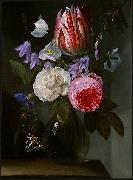 |
Jan Philip van Thielen -- Click Here
|
|
(Mechelen, 1618 - Mechelin, 1667) was a Flemish Baroque painter who specialized in flowers.
Van Thielen was the son of a minor nobleman and eventually assumed the title of Lord of Couwenberch. In 1631 or 1632 he began studying at the age of thirteen with his future brother-in-law, the history painter Theodoor Rombouts (1597-1637), and in 1641 he commenced his studies with the flower painter Daniel Seghers (1590-1661). According to Houbraken (who mistakenly wrote his birth year as 1681 instead of 1618), his reputation during his lifetime was such that he received patronage from the Spanish crown, |
|
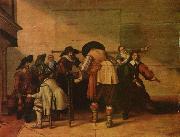 |
Jan Olis -- Click Here
|
|
painted Frohliche Gesellschaft in 1644 |
|
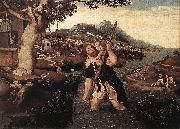 |
Jan Mostaert -- Click Here
|
|
(c. 1475 -1555/1556) was a Dutch painter of portraits and religious subjects, though his most famous creation was the "West Indies Landscape".
Although little is known of him, Mostaert was born and lived in Haarlem for most of his life. He worked as portraitist for Margaret of Austria, Regent of the Netherlands.
Much of his work was destroyed in the great fire of Haarlem in 1576, and some paintings once attributed to him are now attributed to Adriaen Isenbrant.
Mostaert was born in or about 1475 in Haarlem, Netherlands, to a famous noble family. Said to be handsome, eloquent and polite, Mostaert honed his craft under the guidance of Jacob van Haarlem, who may have actually been the anonymous "Master of the Brunswick Diptych". He is also said to be linked to the early Haarlem School of Painting. Mostaert's name first appeared in city records in 1498, the year he married and bought a house in his birthplace. He is also mentioned in Haarlem archives from 1527 to 1554. In 1500 Mostaert was commissioned to paint the shutters for a receptacle housing the relics of Saint Bavo in the Groote Kerk, Haarlem. From this date he began to be listed in the records of the Haarlem Guild of St. Luke, and continued to be frequently listed until 1549. He became deacon of the painters' guild in 1507, and again in 1543 and 1544.
His earliest works are noticeably influenced by Geertgen tot Sint Jans, an earlier Haarlem artist. Some believed that Mostaert was actually apprenticed to tot Sint Jans but it is doubtful that the artist had any apprentices or workshop assistants during his career. From tot Sint Jans, Mostaert adopted a refined style and thoughtful compositions for his works, as well as the stiff, angular look of his figures.
St. ChristopherBetween 1510 and 1516 Mostaert developed a delicate style where his doll-like figures inhabited bright, blue-skied landscapes, as for example in his "Adoration of the Magi" (c. 1510-15). His refined brushwork is precise, with an almost religious attention to detail. Also of note is the landscape, which demonstrates his leanings towards more romantic views with expansive hills. During the 1520s Mostaert was also influenced by Joachim Patinir's take on landscapes. Mostaert's "St. Christopher", a painting with a landscape that features a river receding into an expansive and hilly background, was once even attributed to Patinir.
Mostaert's portrait work of this earlier period includes a piece entitled "Portrait of Abel van den Coulster" (c. 1500-10), in which an elegant, thin-faced man is situated in equally elegant surroundings. Mostaert was known for copying original portraits for some of his courtly commissions but, as is the case with the "Portrait of Abel", he also painted figures from life and added aristocratic touches. He was known for presenting his portrait sitters in three-quarter-length and placing their hands on cushions. |
|
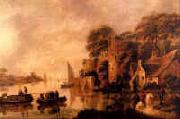 |
Jan Miense Molenaer -- Click Here
|
|
Dutch Baroque Era Painter, ca.1610-1668
was a Dutch genre painter whose style was a precursor to Jan Steen's work during Dutch Golden Age painting. He shared a studio with his wife, Judith Leyster, also a genre painter, as well as a portraitist and painter of still-life. Both Molenaer and Leyster may have been pupils of the successful Dutch painter, Frans Hals.
Molenaer achieved a style close to Hals early on in his career, but later developed a style like that of Dutch genre painter, Adriaen van Ostade. His genre works often depicted players of music, such as his The Music Makers (Museum of Fine Arts, Budapest), The Duet ((Seattle Art Museum), or Family Making Music (Frans Hals Museum). He also depicted Taverns and the activities of card games or games of the times such as La main chaude, or in Dutch, Handjeklap, which literally means clapping hands. Molenaer also cleverly depicted biblical stories in his own time and surroundings, such as representing a scene from Peter's Gospel set in a Dutch Tavern in, The Denying of Peter (Museum of Fine Arts, Budapest) |
|
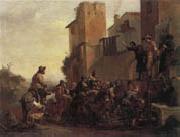 |
Jan miel -- Click Here
|
|
Dutch Baroque Era Painter, ca.1599-1664
Flemish painter, active in Italy. Miel must have arrived in Rome in the early 1630s; he immediately came under the influence of Pieter van Laer (il Bamboccio) and the BAMBOCCIANTI. His earliest paintings of bambocciate (low-life scenes) are the Bowls Players (1633; Paris, Louvre) and its companion piece The Cobbler (Besan?on, Mus. B.-A. & Arch?ol.). Shortly after his arrival in Rome, Miel joined the Schildersbent, a confraternity of Netherlandish artists, and was given the nickname 'Bieco' ('threatening look'). His presence in Rome is documented from 1636 to 1658, when he moved to Turin and entered the service of Charles-Emanuel II, Duke of Savoy. Other early paintings that can be attributed to the 1630s include Halt at the Inn (Marseille, Mus. B.-A.) and Hunters' Rest (Warsaw, N. Mus.). Both are reworkings, in their subject-matter and composition, of contemporary paintings by van Laer, such as his Hunters Resting (Florence, Uffizi) and Halt at the Inn (Paris, Louvre). |
|
|
|
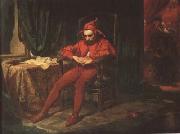 |
Jan Matejko -- Click Here
|
|
Polish Painter, 1838-1893
He studied from 1852 to 1858 at the School of Fine Arts in Krakew and, during this time, started exhibiting historical paintings with the Society of Friends of the Fine Arts there (e.g. Sigismund I Bestowing Nobility on the Professors of the University of Krakew in 1535 (1858; Krakew, Jagiellonian U., Mus. F.A.). After studying in Munich (1859) under the history painter Hermann Anschetz (1802-80) and then briefly and less successfully in Vienna, Matejko returned to Krak?w, where he was based for the rest of his life. In 1860 Matejko issued an illustrated album, Ubiory w Polsce (later editions 1875 and 1901), a project reflecting his intense interest in historical records of all kinds and his desire to promote such interest among the Polish people in an effort to intensify their patriotic feelings. This role first became widely associated with Matejko with his painting of Stanczyk (1862; Warsaw, N. Mus.), the court jester to King Sigismund I (1437-1548), to whom Matejko gave his own features. The jester is presented as a symbol of the nation's conscience |
|
|
|
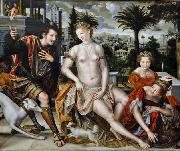 |
Jan Massijs -- Click Here
|
|
painted David and Bathsheba in 1562 |
|
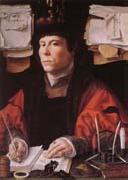 |
Jan Mabuse -- Click Here
|
|
c. 1478 C October 1, 1532
Flemish painter, b. Maubeuge. His real name was Jan Gossaert or Gossart. He may have studied in Bruges before joining the Antwerp guild in 1503. In 1508 he went for a year with his patron, Philip of Burgundy, to Italy, where he was strongly influenced by Italian art and ancient sculpture. He was among the first Flemish artists to represent the nude and classical mythology in a manner derived from Italy. His forms are solid and heavy, and their surfaces are rendered with smooth precision. Mabuse also executed some impressive portraits. The imperious attitude he gave to his subjects was highly popular in his time. A Donor and His Wife (Brussels), Neptune and Amphitrite (Berlin), Danaë (Munich), St. Luke Painting the Virgin (versions in Vienna and National Gall., Prague), and Jean Carondelet Adoring the Virgin (Louvre) are characteristic paintings. |
|
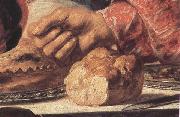 |
Jan lievens -- Click Here
|
|
Dutch Baroque Era Painter, 1607-1674
Dutch painter, draughtsman and printmaker. His work has often suffered by comparison with that of Rembrandt, with whom he was closely associated from 1625 to 1631. Yet Lievens's early work is equal to that of Rembrandt, although in later years he turned more towards a somewhat facile rendering of the international Baroque style favoured by his noble patrons, thus never fully realizing his early promise. |
|
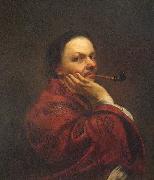 |
Jan Kupecky -- Click Here
|
|
(in German: Johann Kupetzky, in Hungarian: Kupecky Jenos, or Kupeczky Jenos, 1667, Bazin, Royal Hungary (today Slovakia) - 1740, Nernberg, Germany) was a Czech and Slovak portrait painter during the baroque. He was active in Hungary, Slovakia, Vienna and Nernberg.
Kupecký, like many people at that time, was the son of Protestant (Czech Brethren) parents from the Czech lands (Mlade Boleslav) who sought refuge in Slovakia (constituting the core of Royal Hungary at that time) from religious persecution by the Catholics. He was born in Pezinok - a town near Bratislava.
According to the sources he began his studies with the Swiss painter Benedikt Klaus, who was active in both Vienna and in Royal Hungary. At the age of twenty, Kupecký went on a long Italian study trip. In Rome Prince Aleksander Benedykt Sobieski, the son of the Polish king John III Sobieski, helped him to become famous. He returned to Vienna in 1709, after twenty-two years spent in Venice and Rome. We know very little of his Italian activity as well as his early works and his setting in Vienna.
According to his contemporary biographer, the Swiss Johann Caspar Fessli, the Protestant Kupecký, who faithfully clung to his ancestor's religion, remained withdrawn and isolated in Vienna's Catholic milieu, which was under the influence of the court and the aristocracy. However this concept is partly contradicted by the fact that the master had significant courtly commissions while working in Vienna. He painted portraits of various members of the dynasty, Prince Eugene of Savoy, several aristocrats, and, in Karlovy Vary, even of the Russian Czar Peter I. The rich ceuvre of this period comprises a series of gorgeous portraits of Kupecky's family, friends and the painter himself, as well as several persons, whose identity in unknown.
In 1733 Kupecký, fearing religious persecution, fled from Vienna to Nernberg with his family and worked there until his death in 1740. As the most significant portrait painter of contemporary Germany, he was commissioned by a large number of German princes, church dignitaries rich merchants and scholars, and his works were popularized by engravings even during his lifetime. Through his pupils and followers Kupecký's influence and artistic example remained alive and widespread for a long time.
|
|
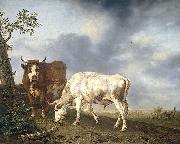 |
Jan Kobell -- Click Here
|
|
(born Delfshaven, 1779; died Amsterdam, 14 September 1814) was a Dutch animal and landscape painter.
He was a pupil of Willem Rutgaart van der Wall at Utrecht. He studied diligently from nature, and took Paul Potter for his model, acquiring his talent for animal as well as landscape work. In 1812 he went to Paris, where he won the gold medal and high praise from art critics. His popularity increased rapidly until his premature death. Of his cattle pieces, noted for their technique and precision of drawing, there are excellent specimens in the museums of Amsterdam and Rotterdam.
|
|
 |
Jan josephsz van goyen -- Click Here
|
|
Dutch , Leyden 1596-The Hague 1656
was a Dutch landscape painter. Van Goyen was an extremely prolific artist; approximately twelve hundred paintings and more than one thousand drawings by him are known. Jan van Goyen was the son of a shoemaker and started as an apprentice in Leiden. Like many Dutch painters of his time, Jan van Goyen studied art in the town of Haarlem with Esaias van de Velde. At age 35, he established a permanent studio at Den Haag (The Hague). Crenshaw tells (and mentions the sources) that Van Goyen's landscape paintings rarely fetched high prices, but he made up for the modest value of individual pieces by increasing his production, painting thinly and quickly with a limited palette of inexpensive pigments. Despite his market innovations, he always sought more income, not only through related work as an art dealer and auctioneer but also by speculating in tulips and real estate. Although the latter was usually a safe avenue of investing money, in Van Goyen's experience it led to enormous debts. Paulus Potter rented one of his houses. Nicolaes van Berchem became his pupil. In 1652 and 1654 he was forced to sell his collection of paintings and graphic art, and he subsequently moved to a smaller house. He died in 1656, still unbelievably 18,000 guilders in debt, forcing his widow to sell their remaining furniture and paintings. |
|
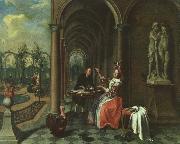 |
Jan Josef Horemans the Elder -- Click Here
|
|
1682-1759
Dutch
Jan Josef Horemans Galleries
He was a pupil of the sculptor Michiel van der Voort I and then of the Dutch painter Jan van Pee (before 1640-1710), who was active in Antwerp. Horemans joined the Guild of St Luke in 1706-7. He appears to have followed in the footsteps of the 17th-century Flemish genre painters, executing a few portraits and a large number of small anecdotal pictures that were highly prized on the market. In paintings such as the Village School and the Cobbler's Shop (both 1712; Vienna, Ksthist. Mus.), the Musical Company (1715; Brunswick, Herzog Anton Ulrich-Mus.) and the Card-players (Florence, Uffizi) he represented scenes from contemporary everyday life that combine observation with a certain degree of stiffness. Most of his paintings are signed. In 1746, together with his son Jan Josef Horemans II, he painted the Abbot of St Michel Visiting the Order of the Fencing Oath (Antwerp, Kon. Mus. S. Kst.). |
|
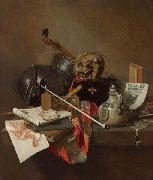 |
Jan Jansz. Treck -- Click Here
|
|
(1606, Amsterdam, 25 September 1652 ) was a still-life painter during the Dutch Golden Age. Treck used economy in the number of his objects.
In 1623 Treck was trained for half a year by Jan den Uyl, who had married his sister Geertruid in 1619. His style also shows influence by Pieter Claesz and Willem Heda. In 1643 and 1644 Treck was trained by Abraham Jansz for 4 guilders a week, but forgot to pay for his apprenticeship. He also had to pay for a window that was made to get more light, while working.
His earliest known signed and dated work is from 1641, after the death of Den Uyl. A work has surfaced with both signatures, implying that Treck perhaps finished Den Uyl's paintings after his death. Treck also had helped his brother-in-law to sell his house (on Singel) in 1639. After the death of his friend Abraham, Treck bought his equipment, paint and easel. In 1640 he supplied the art dealer Hendrick Uylenburgh with money.
After Treck's death his brother, sister and his niece and nephews inherited a small house in an alley from Singel to Spuistraat, furniture, clothes, stocks, coins, jewelry, prints and paintings. In 1661 Simon Luttichuys was asked to repaint a vanitas done by Treck.
Treck influenced Pieter van Anraedt and Willem Kalf. |
|
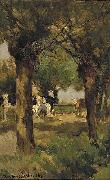 |
Jan Hendrik Weissenbruch -- Click Here
|
|
painted Milking cows underneath the willows in |
|
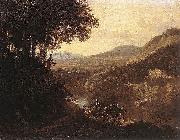 |
Jan Hackaert -- Click Here
|
|
(1628-1685) was a Dutch Golden Age painter.
He travelled in Germany and Switzerland, and painted and sketched mostly landscapes.He would sketch miners at work in the mountains, and on more than one occasion this caused him trouble because the workers couldn't understand what he was doing. They felt he was either a spy or hexing them and made a complaint. Because Italianate landscapes were so fashionable, his Lake Zurich was mistaken for an Italian lake for years.
He painted the landscape backgrounds for other painters, such as Nicolas Berchem and Adriaen van de Velde.
|
|
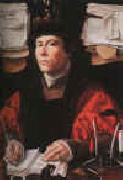 |
Jan Gossaert Mabuse -- Click Here
|
|
1478-1534
Flemish
Jan Gossaert Mabuse Galleries |
|
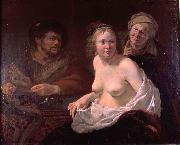 |
Jan Gerritsz. van Bronckhorst -- Click Here
|
|
(1603-1661) was a Dutch Golden Age painter and engraver. He is considered today to be a minor member of the Utrecht Caravaggisti group.
According to Houbraken, van Bronckhorst apprenticed as an eleven-year-old with the glass engraver Verburgh in Utrecht. He worked with him for 6 months and worked with two other Utrecht glassworkers before embarking on a Grand Tour in 1620. He did not get far before he was offered work in Arras by the glassworker Peeter Matthys. After six months, he continued on to Paris in 1620, where he worked with the glassworker Chamu. He returned to Utrecht in 1622, where Cornelis Poelenburg taught him to paint. He married Catalijntje van Noort in 1626. He frequented the studio of Gerard van Honthorst. In 1647 he moved to Amsterdam where he created the stained glass windows and the organ doors (almost the only area in a Calvinist church where figurative painting was sometimes allowed) of the Nieuwe Kerk (finished in 1655). He has been described as the last of the great stained glass painters in Holland.. Unlike his work for churches, his secular paintings show the influence of Caravaggio, and also show a striking appeal to sensuality. Among his pupils are counted his sons Jan Jansz and Gerrit Jansz, and Cesar van Everdingen. |
|
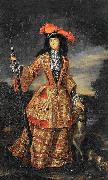 |
Jan Frans van Douven -- Click Here
|
|
Jan Frans van Douven, or Johan Francois Douven, (Roermond, 2 March 1656 - Desseldorf, 1727) was a Southern Netherlandish portrait painter belonging to the Dutch Leyden School. Born in Roermond, he spent most of his life as Court painter in Desseldorf, now in Germany, where he created most of his worksDate circa 1695(1695)
Medium oil
|
|
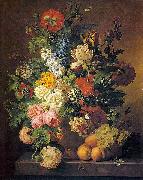 |
Jan Frans van Dael -- Click Here
|
|
an excellent painter of fruit and flowers, was born at Antwerp in 1764, but went early to Paris and settled there. He was self-inatructed in art, but made such progress that he soon distinguished himself at the exhibitions, on one occasion obtaining the prize of 4000 francs, and on two others, the large gold medal. His style is in the manner of Van Huysum and Van Spaendonck, although he did not confine himself strictly to fruit and flowers, but painted other subjects, in which such objects might with propriety be introduced. Two of his pictures, which he painted for the Empress Josephine, represent 'An Offering to Flora,' and 'The Tomb of Julia'; the latter is now in the Louvre. His master-piece, known as 'La Croisee,' the fruit of three years' labour, was likewise purchased by the Empress Josephine, and is now in a private collection at Liege. He was also patronized by the Empress Marie Louise, who took one of his pictures with her to Parma. He died in Paris in 1840, and was buried in the cemetery of Pere Lachaise by the side of his friend Van Spaendonck. The Louvre has also by him three pictures of 'Flowers' and one of 'Fruit.' |
|
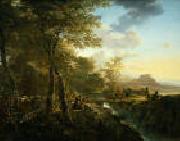 |
Jan Dirksz Both -- Click Here
|
|
Dutch
1610-1652
Jan Dirksz Both (between 1610 and 1618, Utrecht - Aug 9 1652, Utrecht), brother of Andries Both, was a Dutch painter.
From 1634 to 1637 he was taught by Bloemaert and the painter Gerard van Honthorst before travelling to Rome ca. 1637. There he met the French painter Claude Lorrain, with whom he collaborated on a series of landscape paintings. His landscapes are typically peopled by peasants driving cattle or travellers gazing on Roman ruins in the light of the evening sun The everyday life of the streets of Rome became a favourite theme in his works. On his return to Utrecht after the death of his brother in 1642, he stopped producing genre pieces and focused instead on pictures of Italian landscapes bathed in a warm, golden light. This theme was adopted by several other Dutch painters, the Italianites.
|
|
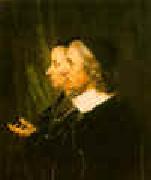 |
Jan de Bray -- Click Here
|
|
1627-1697 Dutch
Painter, draughtsman and etcher, son of (1) Salomon de Bray. He spent virtually the whole of his career in Haarlem, except for the period 1686-8, when he lived in Amsterdam. After training with his father, Jan began working as a portrait painter in Haarlem in 1650, an activity he continued for the next 40 years. Between 1667 and 1684 he served on the committee for the Haarlem Guild of St Luke, whose leading members he portrayed in a picture dated 1675 (Amsterdam, Rijksmus.) that includes a self-portrait (Jan is seen standing and drawing on the left). He married three times, in 1668, 1670 and 1672. His first two wives died a year after their marriage, his third two years afterwards, and in each case the death was followed by disputes over the inheritance. Jan bankruptcy of 1689 may have been a result of one of the lawsuits. He was 62 at the time, and from then onwards he seems to have lost his artistic drive, crushed by the financial blow and the consequent loss of social position. |
|
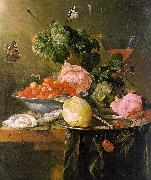 |
Jan Davidz de Heem -- Click Here
|
|
1606-1684
Dutch
Jan Davidz de Heem Galleries |
|
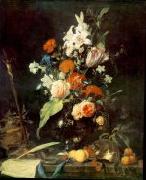 |
Jan Davidsz. de Heem -- Click Here
|
|
stilllife masters, Dutch Baroque Era Painter, 1606-C.1683 |
|
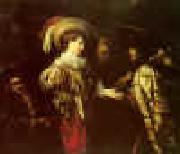 |
Jan Cossiers -- Click Here
|
|
1600-1671
Flemish
Jan Cossiers Location
Flemish painter and draughtsman. After serving an apprenticeship with his father, Anton Cossiers ( fl 1604-c. 1646), and then with Cornelis de Vos, he went first to Aix-en-Provence, where he stayed with the painter Abraham de Vries (1590-1650/62), and then to Rome, where he is mentioned in October 1624. By 1626 he had returned to Aix and had contact with, among others, Nicolas-Claude Fabri de Peiresc, the famous humanist, who recommended him to Rubens. By November 1627 Cossiers had settled back in Antwerp. The following year he became a master in the Guild of St Luke, and in 1630 he married for the first time; he married a second time in 1640. |
|
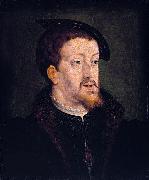 |
Jan Cornelisz Vermeyen -- Click Here
|
|
(c.1500-1559) was a Dutch Northern Renaissance painter.
According to Karel van Mander he was born in Beverwijk in 1500 and was honored for his career in the service of Charles V. He was a friend of Jan van Scorel and his portrait was engraved by Jan Wierix for Dominicus Lampsonius.
Vermeyen was a painter and tapestry designer, probably a pupil of Jan Mabuse. About 1525 he became Court Painter to Margaret of Austria, regent of the Netherlands at Mechelen and in 1535 he accompanied the Emperor Charles V, at the Conquest of Tunis (1535). This journey supplied him with scenes for later works, including tapestries designed 1545/48 for the Regent, Mary of Hungary. He died in Brussels.
Many portraits are ascribed to him on very little evidence, according to modern scholars.
|
|
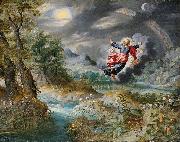 |
Jan Brueghel the Younger -- Click Here
|
|
(September 13, 1601 C September 1, 1678) was a Flemish Baroque painter, and the son of Jan Brueghel the Elder.
He was trained by his father and spent his career producing works in a similar style. Along with his brother Ambrosius, he produced landscapes, allegorical scenes and other works of meticulous detail. Brueghel also copied works by his father and sold them with his father's signature. His work is distinguishable from that of his parent by being less well executed and lighter.
Jan the Younger was traveling in Italy when his father died of cholera and swiftly returned to take control of the Antwerp studio. He soon established himself and was made dean of the Guild of Saint Luke in 1630. That same year he was commissioned by the French court to paint Adam Cycle. In the following years, he also produced paintings for the Austrian court, and worked independently in Paris, before returning to Antwerp in 1657. He collaborated with a number of prominent artists including Rubens, Hendrick van Balen (1575-1632), Adriaen Stalbemt (1580-1682), Lucas Van Uden (1596-1672), David Teniers the Younger and his father-in-law Janssen. Jan the Younger's best works are his extensive landscapes, either under his own name or made for other artists such as Hendrick van Balen as backgrounds.
|
|
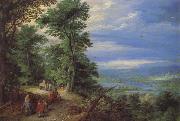 |
Jan Brueghel The Elder -- Click Here
|
|
Flemish Baroque Era Painter, 1568-1625
was a Flemish painter, son of Pieter Brueghel the Elder and father of Jan Brueghel the Younger. Nicknamed "Velvet" Brueghel, "Flower" Brueghel, and "Paradise" Brueghel, of which the latter two were derived from favored subjects, while the former may refer to the velveteen sheen of his colors or to his habit of wearing velvet. He was born in Brussels. His father died in 1569, and then, following the death of his mother in 1578, Jan, along with his brother Pieter Brueghel the Younger ("Hell Brueghel") and sister Marie, went to live with their grandmother Mayken Verhulst (widow of Pieter Coecke van Aelst). She was an artist in her own right, and according to Carel van Mander, possibly the first teacher of the two sons. The family moved to Antwerp sometime after 1578. He first applied himself to painting flowers and fruits, and afterwards acquired considerable reputation by his landscapes and sea-pieces. He formed a style more independent of his father's than did his brother Pieter the Younger. His early works are often landscapes containing scenes from scripture, particularly forest landscapes betraying the influence of the master forest landscape-painter Gillis van Coninxloo. Later in his career, he moved toward the painting of pure landscapes and townscapes, and, toward the end, of still lifes. After residing long at Cologne he travelled into Italy, where his landscapes, adorned with small figures, were greatly admired. He left a large number of pictures, chiefly landscapes, which are executed with great skill. Many of his paintings are collaborations in which figures by other painters were placed in landscapes painted by Jan Brueghel. |
|
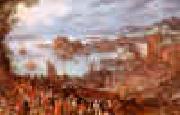 |
Jan Brueghel -- Click Here
|
|
1568-1625
Flemish Jan Brueghel Locations
Jan Brueghel the Elder (b. 1568, Brussels - January 13th 1625, Antwerp) was a Flemish painter, son of Pieter Brueghel the Elder and father of Jan Brueghel the Younger. Nicknamed Velvet Brueghel, Flower Brueghel, and Paradise Brueghel, of which the latter two were derived from favored subjects, while the former may refer to the velveteen sheen of his colors or to his habit of wearing velvet.
Bouquet, painted 1603. The Entry of the Animals Into Noah Ark, painted 1613.His father died in 1569, and then, following the death of his mother in 1578, Jan, along with his brother Pieter Brueghel the Younger (Hell Brueghel) and sister Marie, went to live with their grandmother Mayken Verhulst (widow of Pieter Coecke van Aelst). She was an artist in her own right, and according to Carel van Mander, possibly the first teacher of the two sons. The family moved to Antwerp sometime after 1578.
He first applied himself to painting flowers and fruits, and afterwards acquired considerable reputation by his landscapes and sea-pieces. He formed a style more independent of his father than did his brother Pieter the Younger. His early works are often landscapes containing scenes from scripture, particularly forest landscapes betraying the influence of the master forest landscape-painter Gillis van Coninxloo. Later in his career, he moved toward the painting of pure landscapes and townscapes, and, toward the end, of still lifes.
After residing long at Cologne he travelled into Italy, where his landscapes, adorned with small figures, were greatly admired. He left a large number of pictures, chiefly landscapes, which are executed with great skill. |
|
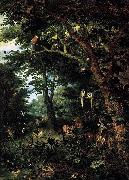 |
Jan Breughel -- Click Here
|
|
painted Paradise in ca. 1620 |
|
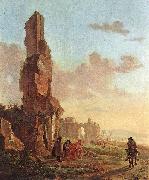 |
Jan Both -- Click Here
|
|
Jan Dirksz Both (between 1610 and 1618 - August 9, 1652) Jan Both was a Dutch painter, draughtsman, and etcher, who made an important contribution to the development of Dutch Italianate landscape painting.
Both was born in Utrecht, and was the brother of Andries Both. According to Houbraken, the brothers first learned to paint from their father, who was a glass-painter or glazier there. Later Jan was a pupil of Abraham Bloemaert and still later the brothers traveled together to Rome via France. Gerrit van Honthorst has also been suggested as a teacher.
By 1638 Jan and his brother Andries were in Rome where Andries concentrated on genre works in the manner of Pieter van Laer, while Jan concentrated on landscapes in the manner of Claude Lorrain.[1] In 1639 Jan collaborated with Herman van Swanevelt and Claude Lorrain on a project for the Buen Retiro Palace in Madrid. Certainly by 1646 Jan had returned to Utrecht, where he refined further his expansive, imaginary landscapes drenched with a Mediterranean golden light. In Landscape with Bandits Leading Prisoners (Museum of Fine Arts, Boston) the sandy road makes a sweeping diagonal from the left. Touches of realism in the down-to-earth figures and detailed vegetation of the foreground contrast with the idyllic golden distance. Occasionally Both peoples his landscapes with religious or mythological figures as in Judgement of Paris (London, National Gallery) where the figures were painted by a fellow Utrecht artist, Cornelis van Poelenburch. Jan's brother Andries (c.1612-41), who specialised in peasant scenes, died in Venice as they were returning to Utrecht. |
|
 |
Jan Bogumil Plersch -- Click Here
|
|
painted Tadeusz Kosciuszko falling wounded in the battle of Maciejowice in 1794 |
|
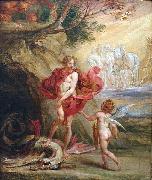 |
Jan Boeckhorst -- Click Here
|
|
Born in Westphalia, in either Menster or Rees, Boeckhorst moved to Antwerp around 1626. He had a close relationship with Rubens's studio, finishing paintings designed by that master as well as assisting with large series such as the joyous entry of Cardinal-Infante Ferdinand in 1635 and the Torre de la Parada. He also collaborated as a figure painter in landscapes and still lifes by Jan Wildens and Frans Snyders, and sometimes painted lively group portraits.[1] He traveled to Italy in the years 1635-1639 and joined the Bentvueghels with the nickname Lange Jan (Tall John).
Cornelis de Bie, in his Gulden Cabinet der Edel Vry Schilderconst (The Golden Cabinet of the Honourable Free Art of Painting; 1662), remarks that Boeckhorst was a student of Jordaens. Works in that master's style include large genre paintings of the 1640s such as Peasants going to Market (Antwerp, Rubenshuis), which also acts as an allegory of the four elements.
In the 1650s and 1660s Boeckhorst painted altarpieces for churches throughout Flanders and designed cartoons for tapestries.
|
|
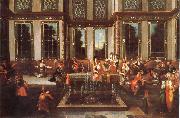 |
Jan Baptiste Vanmour -- Click Here
|
|
1671-1737
was a Flemish-French painter, remembered for his detailed portrayal of life in the Ottoman Empire during the Tulip Era and the rule of Sultan Ahmed III. Van Mour was a native of Valenciennes, a Flemish town that at he time of his birth belonged to the Spanish Netherlands, but since 1678 to France. He studied art in the studio of Jacques-Albert Gerin, and his work attracted the attention of an aristocrat and statesman of the time, Marquis Charles de Ferriol. Van Mour was invited to go to Istanbul when De Ferriol was appointed there as the French Ambassador in 1699. De Ferriol commissioned van Mour to do one hundred portraits of the local people. In 1711 De Ferriol returned to France and van Mour worked for a variety of other diplomats. In the meantime De Ferriol published a series of one hundred engravings (after the paintings) in Recueil de cent estampes representant differentes nations du Levant. The book had a great influence in Western Europe and was published in at least five languages. Painting audiences with the Sultan became van Mour's speciality; he only had to change the setting and a few faces. Van Mour worked with assistants to fulfill all his obligations. In 1725 he was granted the extraordinary title of Peintre Ordinaire du Roy en Levant in recognition of both his and the Levant's importance to the French government. In 1727 the Dutch ambassador Cornelis Calkoen asked Van Mour to record his audience with Sultan Ahmed III on canvas. Van Mour was allowed to enter the palace during these ceremonies accompanying the ambassador and his retinue; therefore, he was familiar with the special protocol that prevailed in the Ottoman court for ambassador's receptions. Calkoen took many paintings of Jean-Baptiste van Mour with him, when he was appointed as ambassador in Dresden for the Dutch Republic. |
|
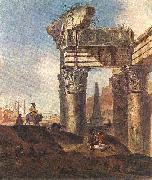 |
Jan Baptist Weenix -- Click Here
|
|
(Amsterdam, 1621- Vleuten 1660), a painter of the Dutch Golden Age. Despite his relatively brief career, he was a very productive and versatile painter. His favourite subjects were Italian landscapes with large figures among ruins, seaside views, and, later in life, large still life pictures of dead game or dogs. He was mainly responsible for introducing the Italian harbour scene into Dutch art, in mid-size paintings with a group of figures in the foreground.
Weenix was the son of an architect and born near Amsterdam's harbour. He could not speak well, apparently from a medical condition, and because he very much liked to read books, his mother sent him to work for a bookseller, who was not able to deal with him. He drew whenever he could, according to Jan Weenix his son, who told the story to Arnold Houbraken.
Weenix first studied under Jan Micker, then in Utrecht under Abraham Bloemaert, and later back in Amsterdam under Claes Cornelisz. Moeyaert. In 1643 Weenix travelled to Rome with Nicolaes Pieterszoon Berchem. He had left his home secretly, but his wife, the daughter of Gillis d'Hondecoeter, traced him to Rotterdam. Then he was allowed to stay away for four months. In Rome he became a member of the Bentvueghels and was much esteemed and worked for Pope Innocent X. He returned to Amsterdam after four years; his wife had refused to come to Rome.
In 1649 he became master of the guild of St. Luke in Utrecht and also painted a portrait of Rene Descartes. When his brother-in-law Gijsbert d'Hondecoeter died, he trained his nephew Melchior d'Hondecoeter, together with his own son Jan Weenix. Weenix moved to a castle outside Utrecht, to concentrate on his work or for health reasons, where he probably died in poor circumstances, at an unknown date.
He painted a few religious scenes, one of the rare pieces of this kind being the "Jacob and Esau" (Gemäldegalerie Alte Meister, Dresden). In the National Gallery, London, is a "Hunting Scene" by Weenix, and Glasgow has a characteristic painting of ruins. Weenix is represented at most of the important continental galleries, notably at Munich, Vienna, Berlin, Amsterdam, and St Petersburg.
|
|
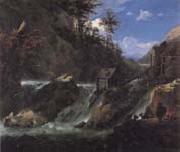 |
Jan Asselijn -- Click Here
|
|
born: Netherlands; about 1615
died: Amsterdam, Netherlands ; 1652. Italianate syle painter with big vistas small people and romantic skys |
|
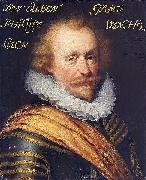 |
Jan Antonisz. van Ravesteyn -- Click Here
|
|
(1572(?) - buried June 21, 1657) was a successful painter to the Dutch court in The Hague.
Van Ravensteyn was born in The Hague. It is unknown who taught him how to paint, but he was a follower of the Delft portrait painter Michiel Jansz van Mierevelt. Van Ravesteyn is mentioned there in the city archives 1597. From 1598 until his death he lived in the Hague, where in 1598 he became a member of the Guild of St. Luke of the Hague. In 1604 he married Anna Arentsz van Berendrecht and in the same year he was mentioned as a good painter by Karel van Mander (though his earliest dated works are from 1611). In 1608 he bought a house on the Molstraat and in 1628 he moved in the Molstraat. In 1640 his wife was buried and in the same year his daughter Marie married one of his pupils, the painter Adriaen Hanneman. In 1654 he moved to the Nobelstraat next to the house of his daughter. In 1656 he left the guild with a group of dissatified painter friends and was one of the founders of the Confrerie Pictura. He was a Catholic and his name occurs often as a witness in the records of the church in the Molstraat, such as for the marriage of his daughter Agnes in 1641 with Willem van Culemborgh. His portrait was painted by Sir Anthony van Dyck and he produced Schutterstuk works. His workshop produced many portraits for the royal house of Nassau and he competed with Miereveld for several commissions.
Van Ravesteyn was in turn, the teacher of Dirck Abrahamsz., Leendert Barthouts, Johannes Harmensz. Borsman, Aelbert Dircksz. Coeppier, Pieter Craen, Jacob Dirksz. van den Enden, Fransise de Goltz, Adriaen Hanneman, Barent Jansz., Thomas Ouwater, Clement Ram, Jan Rassenbourch, Frederick Sonnius, Dirck Verlaer, Jan Pous Voet and Pauwels Willemsz.
|
|
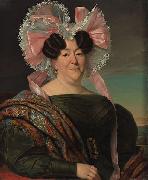 |
Jan Adam Kruseman -- Click Here
|
|
Petrus Augustus de Genestet (P.A. de Genestet) (Amsterdam, November 21, 1829 - Rozendaal, July 2, 1861) was a Dutch poet and a theologian.
Petrus Augustus de Genestet lost both of his parents at a very young age; after that he lived with his uncle, the Dutch painter Jan Adam Kruseman. He studied at the Amsterdamse Atheneum and the Seminarium der Remonstrantse Broederschap to become a preacher. He became minister in March of 1852 at the Genestetkerk (Genestetchurch) that was named after him, in Delft. In the same year he got married to Henriette Bienfait in Bloemendaal. They had two children. In 1859, he lost both his wife and oldest child died of tubercolosis, and because of his poor health he had to quit working as a minister. He moved to Amsterdam, but spent most of his summers in Bloemendaal. Two years later, in 1861, he died in Rozendaal. |
|
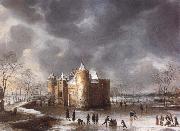 |
Jan Abrahamsz. Beerstraten -- Click Here
|
|
Flemish Baroque Era Painter, ca.1627-1666 |
|
 |
Jan Fyt -- Click Here
|
|
1611-1661
Flemish Jan Fyt Gallery
Flemish painter, draughtsman and etcher.
He was apprenticed in Antwerp in 1621-2 to Hans van den Berch [Berghe] (not to be confused with Jan van den Bergh of Alkmaar) and probably completed his training with Frans Snyders. In 1629-30 Fyt became a master in the Antwerp Guild of St Luke, but he continued to work for Snyders until 1631. In 1633 and 1634 he was in Paris. According to his biographers, he then went to Italy; an Italian journey is confirmed by the fact that in 1650 he joined the Antwerp Guild of Romanists (exclusive to those who had visited Rome), of which he became the dean in 1652. He apparently worked in Rome, where he joined the Schildersbent and was given the nickname Goudvink (Dut.: goldfinch). In Venice, according to Orlandi, Fyt worked for the Sagredo and Contarini families. He is also thought to have visited Naples, Florence and Genoa, and Orlandi stated that he also went to Spain and London. By 5 September 1641 Fyt was back in Antwerp, where, apart from a brief trip to the northern Netherlands in 1642, he apparently remained for the rest of his career. However, Jan-Erasmus Quellinus stated that he again travelled to Italy in the 1650s, a claim supported to some extent by the mention in 1671 of a Self-portrait (untraced) supposedly painted some 20 years earlier in Venice (see 1977 exh. cat.). |
|
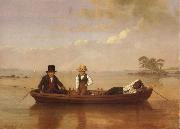 |
James-Goodwyn Clonney -- Click Here
|
|
British/American, 1812-1867, American painter. He was one of the first generation of American genre painters. His earliest datable work includes two lithographs of urban views and images of birds and animals published in New York between 1830 and 1835. He studied at the National Academy of Design, New York, and exhibited there periodically between 1834 and 1852. The first genre painting he exhibited at the National Academy was Militia Training (1841; Philadelphia, PA Acad. F.A.), although another example, In the Woodshed (1838; Boston, MA, Mus. F.A.), predates it. He also exhibited at the Pennsylvania Academy of Fine Arts (1845 and 1847) and at the Apollo Association and American Art-Union (1841-50). |
|
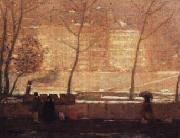 |
James Wilson Morrice -- Click Here
|
|
(August 10, 1865 Montreal - January 23, 1924 Tunis) was a significant Canadian landscape painter. He studied at the Academie Julian in Paris, France, where he lived for most of his career.
Morrice was the son of a wealthy merchant, and studied law in Toronto from 1882 to 1889. In 1890 he left to study painting in England. The next year he arrived in Paris, where he studied at the Academie Julian from 1892-7. At Julians he befriended Charles Conder and Maurice Prendergast, and also met Robert Henri.
Morrice continued to live in Paris until the First World War, although he spent most of his winters in Canada. He made many connections in the intellectual circles of Paris, while also remaining in touch with the Canadian art world:
|
|
|
|
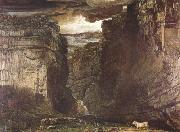 |
James Ward -- Click Here
|
|
English Romantic Painter, 1769-1859
English painter and engraver. He was the most important animal painter of his generation. Many of his dynamic compositions depict horses, dogs or wild animals in agitated emotional states, the sense of movement being reinforced by vigorous brushwork and strong colours. With their sweeping landscapes and dramatic skies, his canvases epitomize Romanticism. Not content to excel merely as an animal painter, Ward also produced portraits, landscapes and genre and history paintings of varying quality. |
|
|
|
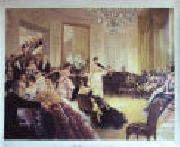 |
James Tissot -- Click Here
|
|
French Painter, 1836-1902
French painter, printmaker and enamellist. He grew up in a port, an experience reflected in his later paintings set on board ship. He moved to Paris c. 1856 and became a pupil of Louis Lamothe and Hippolyte Flandrin. He made his Salon d?but in 1859 and continued to exhibit there successfully until he went to London in 1871. His early paintings exemplify Romantic obsessions with the Middle Ages, while works such as the Meeting of Faust and Marguerite (exh. Salon 1861; Paris. Mus. d'Orsay) and Marguerite at the Ramparts (1861; untraced, see Wentworth, 1984, pl. 8) show the influence of the Belgian painter Baron Henri Leys. In the mid-1860s Tissot abandoned these tendencies in favour of contemporary subjects, sometimes with a humorous intent, as in Two Sisters (exh. Salon 1864; Paris, Louvre) and Beating the Retreat in the Tuileries Gardens (exh. Salon 1868; priv. col., see Wentworth, 1984, pl. 45). The painting Young Ladies Looking at Japanese Objects (exh. Salon 1869; priv. col., see Wentworth, 1984, pl. 59) testifies to his interest in things Oriental, and Picnic (exh. Salon 1869; priv. col., see 1984 exh. cat., fig. 27), in which he delved into the period of the Directoire, is perhaps influenced by the Goncourt brothers. Tissot re-created the atmosphere of the 1790s by dressing his characters in historical costume. |
|
|
|
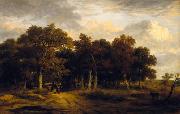 |
James Stark -- Click Here
|
|
(November 19, 1794 - March 24, 1859) was an English landscape painter of the "Norwich School".Stark was born in Norwich, the youngest son of distinguished dyer Michael Stark (1748-1831, Scottish), and showed a talent for art from an early age. He was educated at the Grammar School where he was friends with John Berney Crome. He was then apprenticed for 3 years to John Berney's father, distinguished landscape artist John Crome, from 1811.
In that same years he exhibited work at the Norwich Society of Artists (being elected a member in 1812,) and his work "A view on King Street river, Norwich" was shown by the Royal Academy, London. In 1814 he moved to London, exhibiting at the British Institution between 1814-18, winning a prize of £50 in 1818. In 1817 he entered the Royal Academy as a student, and eventually began to receive commissions for his work.
Ill health forced Stark to return to Norwich after only 2 years study. There he devoted himself to painting the scenery around the city and executed a series of paintings of Norfolk rivers which were eventually engraved and published in 1834. In 1821 he married Elizabeth Younge Dinmore (d. 1834-35).
In 1830, he again settled in London, taking up residence in Chelsea, and exhibited at the British Institution, Royal Academy and Society of British Artists. In 1839, he moved to Windsor, painting many pictures of the scenery of the Thames, but moved back to London in 1849 in order to further his son's education in art.
Stark died at Mornington Place, Camden, London, in March 1859.
Stark's only son, Arthur James Stark (1831-1902), born in Chelsea, London, became a landscapes and animal painter. On a few of his father's pictures he was employed to draw the cattle.
|
|
 |
James Smetham -- Click Here
|
|
1821-1889
was an English Pre-Raphaelite painter and engraver, a follower of Dante Gabriel Rossetti.[1] Smetham was born in Pateley Bridge, Yorkshire, and attended school in Leeds; he was originally apprenticed to an architect before deciding on an artistic career. He studied at the Royal Academy, beginning in 1843. His modest early success as a portrait painter was stifled by the development of photography (a problem shared by other artists of the time). In 1851 Smetham took a teaching position att the Wesleyan Normal College in Westminster; in 1854 he married Sarah Goble, a fellow teacher at the school. They would eventually have six children. Smetham worked in a range of genres, including religious and literary themes as well as portraiture; but he is perhaps best known as a landscape painter. His "landscapes have a visionary quality" reminiscent of the work of William Blake, John Linnell, and Samuel Palmer.[2] Out of a lifetime output of some 430 paintings and 50 etchings, woodcuts, and book illustrations, his 1856 painting The Dream is perhaps his best-known work. He was also an essayist and art critic; an article on Blake (in the form of a review of Alexander Gilchrist's Life of William Blake), which appeared in the January 1869 issue of the Quarterly Review,[3] influenced and advanced recognition of Blake's artistic importance. Other Smetham articles for the Review were "Religious Art in England" (1861), "The Life and Times of Sir Joshua Reynolds" (1866), and "Alexander Smith" (1868). He also wrote some poetry. Smetham was a devout Methodist, and after a mental breakdown in 1857, the second half of his life was marked by a growing religious mania and eventual insanity. "In one of his notebooks he attempted to illustrate every verse in the Bible."[4] (Smetham habitually created miniature, postage-stamp-sized pen-and-ink drawings, in a process he called "squaring." He produced thousands of these in his lifetime.) He suffered a final breakdown in 1877 and lived in seclusion until his death. Smetham's letters, posthumously published by his widow,[5] throw light upon Rossetti, John Ruskin, and other contemporaries, and have been praised for their literary and spiritual qualities. |
|
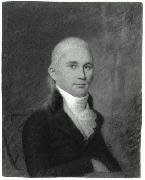 |
James Sharples -- Click Here
|
|
(1751 or 1752 in Lancashire - 26 February 1811 in New York ) was an English portrait painter and pastelist, who moved to the United States in 1794. He first exhibited at the Royal Academy in 1779.
James was first intended for the Catholic priesthood, but became an artist instead.Sharples headed a family of successful portrait artists, including his third wife Ellen Sharples. He had four children, George by his first wife, Felix Thomas Sharples from his second marriage (c. 1786- after 1823), and James Sharples Jr.(c. 1788-1839) and daughter Rolinda Sharples (1793-1838) with this third wife, Ellen. Felix, James Jr. and Rolinda joined the family enterprise at ages 17, 15, and 13 respectively. Before marrying Ellen Wallace, James had been active in Bristol, Liverpool and Bath, where he taught drawing. Ellen was a lady of French extraction who had relations in America. The family left for the United States in 1796, but, according to Ellen's diaries, their ship fell into the hands of the French, and for seven months the family spent time in Brest, near Cherbourg. Landing in New York, James quickly became popular for his small portraits in pastel and his miniatures. From 1796 to 1801 he worked mainly in Philadelphia and New York, securing portrait commissions. The family traveled throughout New England region as itinerant portrait painters, looking for work and making inexpensive copies from the originals portraits they had made of popular and well-known figures, such as George Washington and James Madison.
|
|
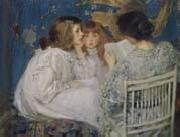 |
James Shannonc -- Click Here
|
|
born in the United States and moved to England in 1878 where he trained at South Kensington
1862-1923
|
|
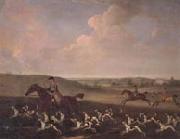 |
James Seymour -- Click Here
|
|
British Painter , ca.1702-1752
English painter and draughtsman. The son of James Seymour (d 1739), a dealer in pictures and precious metals, Seymour was among the first English painters to specialize exclusively in sporting subject-matter. Though he possibly received some informal drawing instruction from the topographer Francis Place, Seymour was essentially a self-taught artist whose education was based on the study of pictures that passed through his father's hands; one of his earliest known works is a sketch of a horse's head after van Dyck (sold London, Christie's, 16 June 1970). His early 'genius to drawing of horses' was, according to George Vertue, compromised by 'modish extravagances' through living 'gay high and loosely' and because he 'never studied enough to paint or colour well'. Elsewhere, however, it was recorded that by 1739 he was 'reckoned the finest draughtsman in his way [of horses, hounds etc.] in the whole world' (Universal Spectator, 1739), and he was certainly preferred to his chief rival, John Wootton, by many sporting patrons. Among his employers was William Jolliffe MP, of Ammerdown. Though many of his paintings are either derivative of Wootton or simply inept, or both, others are characterized by a self-conscious stylistic naivety in which meticulous attention to detail and eerily static compositions combine to create curiously memorable images of some apparent sophistication. |
|
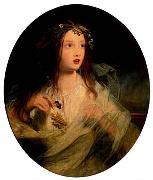 |
James Sant -- Click Here
|
|
(1820-1916) was a British painter specializing in portraits, and a member of the Royal Academy. Sant was born in Croydon and taught by John Varley and Augustus Wall Callcott. He lived to the age of 96 and produced an astonishing number of canvases for exhibition at the Academy, some 250 of them, from 1840 through 1904. He was elected to the RA in 1870, and in 1872 Sant was appointed Principal Painter in Ordinary (official portraitist) to Queen Victoria and the royal family. Sant resigned from the RA in 1914 to "make room for younger men." His work can be found at the Tate Gallery.
His brother George Sant (1821 - 1877) was a landscape painter. His sister Sarah Sherwood Clarke (who married Frederick Clarke, Superintendent and later Secretary of the LWS Railway) was an artist of great talent, but all that remains of her work is a collection of 48 different views of Scotland from 1854; these were exhibited for the first time at the "Watercolours & Works on Paper Fair" in London in February 2010.
|
|
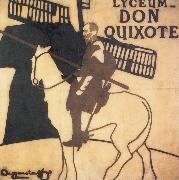 |
James Pryde and William Nicholson -- Click Here
|
|
James Pryde (1866-1941) was a Scottish artist working mainly in graphics.William Nicholson is English Painter, 1872-1949
|
|
 |
James Peele -- Click Here
|
|
James Peale (1749 - May 24, 1831) was an American painter, best known for his miniature and still life paintings, and a younger brother of noted painter Charles Willson Peale.
Peale was born in Chestertown, Maryland, the second child, after Charles, of Charles Peale (1709 - 1750) and Margaret Triggs (1709 - 1791). His father died when he was an infant, and the family moved to Annapolis. In 1762 he began to serve apprenticeships there, first in a saddlery and later in a cabinetmaking shop. After his brother Charles returned from London in 1769, where he had studied with Benjamin West, Peale served as his assistant and learned how to paint.
Peale worked in his brother's studio until January 14, 1776, when he accepted a commission in the Continental Army as an ensign in William Smallwood's regiment. Within three months he was promoted to captain, and during the next three years fought in the battles of Long Island, White Plains, Trenton, Brandywine, Germantown, Princeton, and Monmouth. He resigned his army commission in 1779, and moved to Philadelphia to live with his brother. In 1782 he married, after which he established his own household and artistic career. (One notable later collaboration, however, was in 1788 to make floats for Philadelphia's Federal Procession in honor of the newly drafted United States Constitution.) |
|
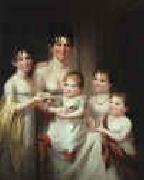 |
James Peale -- Click Here
|
|
1749-1831
James Peale Galleries
James Peale (1749 ?C May 24, 1831) was an American painter, best known for his miniature and still life paintings, and a younger brother of noted painter Charles Willson Peale.
Peale was born in Chestertown, Maryland, the second child, after Charles, of Charles Peale (1709?C1750) and Margaret Triggs (1709?C1791). His father died when he was an infant, and the family moved to Annapolis. In 1762 he began to serve apprenticeships there, first in a saddlery and later in a cabinetmaking shop. After his brother Charles returned from London in 1769, where he had studied with Benjamin West, Peale served as his assistant and learned how to paint.
Peale worked in his brother's studio until January 14, 1776, when he accepted a commission in the Continental Army as an ensign in William Smallwood's regiment. Within three months he was promoted to captain, and during the next three years fought in the battles of Long Island, White Plains, Trenton, Brandywine, Germantown, Princeton, and Monmouth. He resigned his army commission in 1779, and moved to Philadelphia to live with his brother. In 1782 he married, after which he established his own household and artistic career. (One notable later collaboration, however, was in 1788 to make floats for Philadelphia's Federal Procession in honor of the newly drafted United States Constitution.)
At the outset of his career Peale painted portraits and still-life, and by the mid-1780s had established his reputation. At about this time, however, Charles turned over his own miniature portrait practice to him, and throughout the 1790s and early 1800s Peale devoted himself to miniature painting. Much of this work was watercolor on ivory. In 1795 Peale exhibited a still life of fruit along with nine miniatures and his family portrait at the Columbianum, a short-lived art academy in Philadelphia. Around 1810, as Peale's eyesight began to weaken, he gave up painting miniatures to turn to large portraits and still-life subjects that were greatly admired and widely exhibited in Philadelphia, Boston, and Baltimore.
The total number of Peale's landscape paintings remains unknown, but he executed more than 200 watercolor miniatures on ivory, perhaps 100 still-life paintings, fewer than 70 oil portraits, and at least 8 history paintings.
Peale died in Philadelphia on May 24, 1831. Three of his six children became accomplished painters: Anna Claypoole Peale (1798?C1871), a miniaturist and still-life painter; Margaretta Angelica Peale (1795?C1882), painter of trompe l??oeil subjects and tabletop fruit; and Sarah Miriam Peale (1800?C1885), a portraitist and still-life painter. |
|
|
|
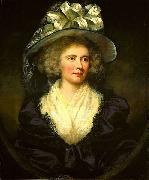 |
James Northcote -- Click Here
|
|
RA (22 October 1746 - 13 July 1831), was an English painter
was born at Plymouth, and was apprenticed to his father, a poor watchmaker. In his spare time, he drew and painted. In 1769 he left his father and set up as a portrait painter. Four years later he went to London and was admitted as a pupil into the studio and house of Sir Joshua Reynolds. At the same time he attended the Royal Academy schools.
In 1775 he left Reynolds, and about two years later, having made some money by portrait painting back in Devon, he went to study in Italy. On his return to England, three years later, he revisited his native county, then settled in London, where John Opie and Henry Fuseli were his rivals. He was elected associate of the Academy in 1786, and full academician in the following spring. The "Young Princes murdered in the Tower," his first important work on a historical subject, dates from 1786, and it was followed by the "Burial of the Princes in the Tower". Both paintings, along with seven others, were intended for Boydell's Shakespeare Gallery. The "Death of Wat Tyler", now in the Guildhall, London, was exhibited in 1787; and shortly afterwards Northcote began a set of ten subjects, entitled "The Modest Girl and the Wanton", which were completed and engraved in 1796. Among the productions of Northcote's later years are the "Entombment" and the "Agony in the Garden," besides many portraits, and several animal subjects, such as "Leopards", "Dog and Heron", and "Lion". |
|
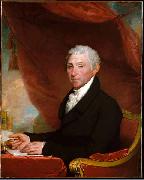 |
James Monroe -- Click Here
|
|
(April 28, 1758 - July 4, 1831) was the fifth President of the United States (1817-1825). Monroe was the last president who was a Founding Father of the United States, and the last president from the Virginia dynasty and the Republican Generation. His presidency was marked both by an "Era of Good Feelings" a period of relatively little partisastrife and later by the Panic of 1819 and a fierce national debate over the admission of the Missouri Territory. Monroe is most noted for his proclamation of the Monroe Doctrine in 1823, which stated that the United States would not tolerate further European intervention in the Americas.
Born in Westmoreland County, Virginia, Monroe fought in the American Revolutionary War. After studying law under Thomas Jefferson from 1780 to 1783, he served in the Continental Congress. As an anti-federalist delegate to the Virginia convention that considered ratification of the United States Constitution, Monroe opposed ratification, claiming it gave too much power to the central government. Nonetheless, Monroe took an active part in the new government and in 1790 he was elected to the Senate, where he joined the Jeffersonians. He gained experience as an executive as the Governor of Virginia and rose to national prominence when as a diplomat in France he helped negotiate the Louisiana Purchase in 1803.
During the War of 1812, Monroe held the critical roles of Secretary of State and the Secretary of War under President James Madison. Facing little opposition from the fractured Federalist Party, Monroe was easily elected president in 1816, winning over 80 percent of the electoral vote. As president, he sought to ease partisan tensions and embarked on a tour of the country. He was well received everywhere, as nationalism surged, partisan fury subsided and the "Era of Good Feelings" ensued. The Panic of 1819 struck and dispute over the admission of Missouri embroiled the country in 1820. |
|
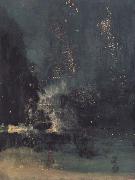 |
James Mcneill Whistler -- Click Here
|
|
American Painter and Printmaker, 1834-1903
James Abbott McNeill Whistler's deft brushwork and mighty ego made him one of London's best-known painters in the second half of the 1800s. Born in Massachusetts, Whistler spent most of his adult life in England and France, in an era when an American artist in Europe was something of a rarity. He specialized in landscapes and (especially later in his career) portraits; stylistically he is often linked with Claude Monet and August Renoir, though he was not exactly part of the Impressionist movement. His etchings also are highly regarded. Witty, cranky and a bit of a devil, Whistler was a regular gadabout in British society. He had a famous long-running feud with the playwright Oscar Wilde, each of them trying to outwit the other with cutting public remarks. Some critics of the era considered Whistler's work to be smudgy and too radical; after viewing Whistler's 1875 study of fireworks over the Thames, Nocturne in Black and Gold: the Falling Rocket, John Ruskin wrote: "I have seen, and heard, much of cockney impudence before now; but never expected to hear a coxcomb ask two hundred guineas for flinging a pot of paint in the public's face." Whistler successfully sued Ruskin for libel but was awarded only a farthing in damages, |
|
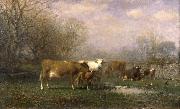 |
James McDougal Hart -- Click Here
|
|
(May 10, 1828 - October 24, 1901), was a Scottish-born American landscape and cattle painter of the Hudson River School. His older brother, William Hart, was also a Hudson River School artist, and the two painted similar subjects.
Hart was born in Kilmarnock, Scotland, and was taken to America with his family in early youth. In Albany, New York he trained with a sign and carriage maker possibly the same employer that had taken on his brother in his early career. Unlike his brother, however, James returned to Europe for serious artistic training. He studied in Munich, and was a pupil of Friedrich Wilhelm Schirmer in Dusseldorf.
Hart returned to America in 1853. He exhibited his first work at the National Academy of Design in 1848, became an associate in 1857 and a full member in 1859. James Hart was particularly devoted to the National Academy, exhibiting there over a period of more than forty years, and serving as vice president late in his life from 1895 to 1899. Like his brother, James also exhibited at the Brooklyn Art Association (he lived for a time in Brooklyn) and at major exhibitions around the country.
Along with most of the major landscape artists of the time, Hart based his operations in New York City and adopted the style of the Hudson River School. While James Hart and his brother William often painted similar landscape subjects, James may have been more inclined to paint exceptionally large works. An example is The Old Homestead (1862), 42 x 68 inches, in the collection of the High Museum of Art in Atlanta, Georgia. James may have been exposed to large paintings while studying in D??sseldorf, a center of realist art pedagogy that also shaped the practices of Albert Bierstadt and Worthington Whittredge. William Hart, who did not seek academic European training, seems to have been more comfortable painting small and mid-sized works.
Like his brother William, James excelled at painting cattle. Kevin J. Avery writes, "the bovine subjects that once distinguished [his works] now seem the embodiment of Hart's artistic complacency." In contrast with the complacency of some of his cattle scenes, his major landscape paintings are considered important works of the Hudson River School. |
|
|
|
|
|
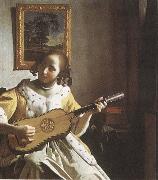 |
james m cain -- Click Here
|
|
Born: 1 July 1892
Birthplace: Annapolis, Maryland
Died: 27 October 1977
Best Known As: Author of The Postman Always Rings Twice
|
|
 |
James Lynwood Palmer -- Click Here
|
|
British artist , 1868 - 1941 |
|
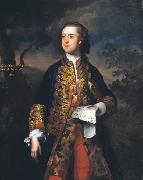 |
James Latham -- Click Here
|
|
James Latham (c. 1696 - 26 January 1747) was an Irish portrait painter.
James Latham was born in Thurles, County Tipperary, Ireland and possibly related to the family of Lathams of Meldrum and Ballysheehan. After some practice of his art, Latham studied for an academic year in Antwerp (1724 - 25) where he became a Master of the Guild of St Luke. He returned to Dublin by 1725, and may have visited England in the 1740s, as the influence of Joseph Highmore, as well as Charles Jervas and William Hogarth, is evident in his work of this period. Anthony Pasquin memorably dubbed Latham "Ireland's Van Dyck". Latham died in Dublin on 26 January 1747.
Several of James Latham's portraits are in the National Gallery of Ireland collection in Dublin; one is of the famous MP Charles Tottenham (1694-1758) of New Ross, Co. Wexford, "Tottenham in his Boots" (Cat. No.411) and a second is a portrait of Bishop Robert Clayton (1697-1758) and his wife Katherine. |
|
 |
James Joseph Jacques Tissot -- Click Here
|
|
James Jacques Joseph Tissot (15 October 1836 - 8 August 1902) was a French painter, who spent much of his career in Britain.
Tissot was born in Nantes, France. In about 1856, he began study at the École des Beaux-Arts in Paris under Hippolyte Flandrin and Lamothe, and became friendly with Edgar Degas and James Abbott McNeill Whistler. Tissot exhibited in the Paris Salon for the first time in 1859, two portraits of women and three scenes in medieval dress from Faust. The latter show the influence of the Belgian painter Henri Leys (Jan August Hendrik Leys), whom he had met in Antwerp in 1859. In the mid-1860s, however, Tissot began to concentrate on depicting women, often although not always shown in modern dress. Like contemporaries such as Alfred Stevens and Claude Monet, Tissot also explored japonisme, including Japanese objects and costumes in his pictures. A portrait of Tissot by Degas from these years (Metropolitan Museum of Art, New York) shows him with a Japanese screen hanging on the wall. |
|
 |
James Jebusa Shannon -- Click Here
|
|
(1862 - 1923), Anglo-American artist, was born in Auburn, New York, and at the age of eight was taken by his parents to Canada.
When he was sixteen, he went to England, where he studied at South Kensington, and after three years won the gold medal for figure painting. His portrait of the Hon. Horatia Stopford , one of the queen's maids of honour, attracted attention at the Royal Academy in 1881, and in 1887 his portrait of Henry Vigne in hunting costume was one of the successes of the exhibition, subsequently securing medals for the artist at Paris, Berlin, and Vienna.
He soon became one of the leading portrait painters in London. He was one of the first members of the New English Art Club, a founder member of the Royal Society of Portrait Painters and in 1897 was elected an associate of the Royal Academy, and RA in 1909. His picture, "The Flower Girl", was bought in 1901 for the National Gallery of British Art.
|
|
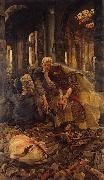 |
James Jacques Joseph Tissot -- Click Here
|
|
(15 October 1836 -- 8 August 1902) was a French painter.
Tissot was born at Nantes. He studied at the École des Beaux-Arts in Paris under Ingres, Flandrin and Lamothe, and exhibited in the Paris Salon for the first time at the age of twenty-three. In 1861 he showed The Meeting of Faust and Marguerite, which was purchased by the state for the Luxembourg Gallery. His first characteristic period made him a painter of the charms of women. Demi-mondaine would be more accurate as a description of the series of studies which he called La Femme a Paris.
|
|
 |
James Hope -- Click Here
|
|
American, born circa 1818-1892 |
|
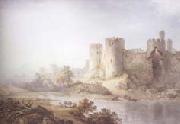 |
James Holworthy -- Click Here
|
|
(d. 1841)
was a British watercolour artist. Some of Holworthy's art can be seen in the Tate Gallery. Holworthy exhibited at the Royal Academy in 1803 and 1804. In the latter year he was one of the foundation members of the Society of Painters in Water-colours, now known as the Royal Watercolour Society,and he contributed constantly to their exhibitions till 1813. His subjects being drawn from Wales, the Lake district, and Yorkshire. He practised in London till 1822. In 1900, there were two drawings by him at the South Kensington Museum. In 1821, Holworthy was living in Barton in the Beans, Leicestershire. In either 1821[2] or 1824 he married Anne Wright,[3] a niece of John Wright in Derby, and retired to the Brookfield estate, near Hathersage in Derbyshire, which he had purchased. He died in London in 1841 |
|
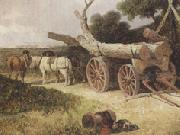 |
James holland,r.w.s -- Click Here
|
|
1799-1870
English painter. As a boy he was employed for seven years to paint flowers on pottery in the factory of John Davenport ( fl 1793; d 1848) of Longport. In 1819 Holland moved to London, where he continued at first to work as a pottery painter but also undertook watercolours of flowers and natural history subjects, exhibiting his works at the Royal Academy from 1824. After 1828 oil paintings predominated over watercolours in the many pictures that he exhibited at the Royal Academy, the Society of Painters in Water-Colours (of which he was made an associate in 1835), the British Institution and the Society of British Artists. He travelled to Paris in 1831 and subsequently made repeated tours of the Continent. Buildings in European cities now became his favourite subject, and above all, scenes of Venice, which he first visited in 1835; his Venetian views have sometimes been confused with those by Richard Parkes Bonington. In 1837 he was commissioned by the Landscape Annual to make drawings in Portugal, which were engraved in the issue for 1839. He travelled again to Venice in 1845, 1851 and 1857, making sketches en route of the Low Countries, France, Switzerland and Austria. |
|
|